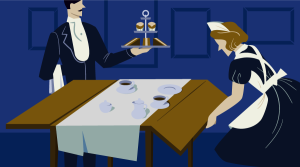You know that sinking feeling, when that dream client – the one you busted your a** to create that bullet proof (or so you thought) proposal for informs you that they’re awarding the project to another party. Someone more established. Someone with more resources. Someone who can deliver the whole deal. And your heart sinks as you realize you’ve lost yet another client to bigger, better(?) agency.
But it doesn’t always have to be that way.
Remember David vs Goliath?
So what if you’re just a freelancer? So what if you’re a lone ranger? That doesn’t mean you’re destined to forever be stuck with cheap clients from hell.
It’s time to get your act together!
Here’s a little Q&A. Have you ever thought about:
* Why do clients really prefer going with an agency?
* Can you provide those same benefits? How?
* What else can you leverage in your favor?
So to get started, let’s first walk through the most common reasons clients tend to prefer agencies, and how you can offer the same benefits.
1. Full Services Offerings

An agency, with its team of specialists, can provide a larger range of services. Instead of just a web design, they can provide a full business analysis, web design and development, ongoing digital market efforts and so on. Clients like this because they don’t need to go to different people for different needs. They can get it all in one place.
Let’s face it: no client wants to have to coordinate between 4 freelancers to get their website and online marketing going!
What can you do?
For clients who want full service, figure out how to give them what they want. Expand your services. No, you don’t need to go learn to code the website or jump into SEO. Remember, we’re playing smart. Make technology your best friend. Learn how to use co-design tools like Webflow or FROONT to create the website, instead of sticking to old Photoshop. This way you can deliver a live, production worthy website, without getting into the hassles of coding.
See how Kasper Friis, a graphic designer, used Froont and Webflow to pitch to Coca Cola.
If required, you can also team up with other freelancers to fill in the gaps that remain, with a sort of hybrid freelance-agency model. This may take some trial and error until you find a developer, SEO expert, and copy-writer who work well with you as a team.
Brian Casel, web designer and entrepreneur uses this hybrid model to expand his web service offerings, and even create web-based products.
2. A Larger Resource Pool
Along with offering more services, an agency also typically has access to a larger resource pool, access to higher end software, a wider range of graphics, etc, that potentially help them serve the client better. Whether or not those are actually used in this project, the possibility of more is a powerful allure.

So what can you do?
Well, you can go out and acquire ALL the tools, etc that a big agency has. Or you can play it smart. Make sure you do have access to the tools and resources that pack the best bang for your buck, that deliver the best value. More isn’t always better.
Don’t turn up for the pitch with rough sketches on paper (well, not unless it is an impromptu pitch in the elevator!). Go prepared. Make sure your sketches and portfolio have a polished, professional appeal. Ooze the confidence and sophistication as if you have the whole world backing you. You’ll be surprised how far just appearance can work in your favor.
Of course, if the client requires some feature or resource you won’t be able to provide, be honest about it. Don’t hide the fact. Integrity still ranks high when it comes to impressing clients.
3. Experience
Yes, experience counts. Agencies use that in their favor. They boast about the 9,845 projects completed or the 5 decades of combined experience their designers have. As a freelancer, you’re not going to be able to pull up those kinds of numbers. Ever.
Yes, experience counts. Agencies use that in their favor.
What do you do?
Don’t compete on numbers. Compete on relevance. And passion. Be selective. Showcase parts of your portfolio that are from the same or similar industry that had similar goals. Dig into your past — work and personal — for a way to connect with them and show that you understand their industry and their needs. Better than all the others who’ve pitched for the job.
And in the odd case that you have absolutely no prior experience that may be relevant… just let your passion shine through. Research the client thoroughly. Understand what their business is about, what their customers want and what their online goals are. When you pitch to them, show them how passionate and capable you are at helping them achieve their goals!
Jacob Cass is only 26. But his passion just shines through at JustCreative. No one’s going to question his experience!
4. Reliability

This one is perhaps more of a perception. An agency with a swanky website, office and a dozen people is perceived to be more reliable. They’re not going to pack up and vanish tomorrow. They’re not going to run away with the money. They most probably have the skills, processes and systems in place to make the workflow smooth. And when the client is talking to 5 or more people, there’s the reassurance that this person is real, versus having only email interaction with a freelancer you’ve never met, and who may vanish overnight.
So what do you do?
There’s no easy way out of this one. You’ve got to build trust. Keeping up a professional front helps alleviate such fears to some extent. Let clients know the best way to get in touch with you. Let them know your work schedule. Set clear expectations about your response time. Provide them with alternate contact numbers or emails. Communicate clearly and provide frequent, relevant updates. If you can, it’s always good to meet the client in person, at least for the pitch. If you can’t meet frequently for updates, try Skype or something similar. Face time counts. Even if it’s on the internet. Show up. Deliver.
You’ve got to build trust.
And of course, play smart and use testimonials from past clients to show how great, and reliable you are. Just like Christina’s done here.
So, now that you’ve all the strategies to convince clients that you’re on par with agencies, what else can you do to sweeten the deal? As a freelancer, you have some unique advantages that agencies don’t. Here’s how to leverage them.
5. Freelancers Have More Flexibility
An agency, even a creative one, usually has a set of processes and systems with 5 different people involved to “OK” every major decision. You’re alone. Or even with your rag tag team of other freelancers, you’re still the boss. You can make decisions faster. You’re agile. You can incorporate changes. You have some room to go with the flow. Play your cards right, and the client may just start trusting you, and relying on you, as if you were a part of their company.
6. Freelancers Have Lower Overheads
As a freelancer there’s no swanky office that you have to pay the lease for; or air conditioning for empty conference rooms. There’s no receptionist. Or cafeteria. You work lean. Probably from home. With minimal overheads. You can afford to keep the costs lower than an agency. While I don’t advocate ever competing on price, you can use this to show that you’re more cost effective and therefore, provide a better ROI. Now, which client doesn’t like a better return on their investment?!
Go Get ‘Em!
So what if you’re a small town designer? We showed you how to compete and win against an agency. It’s all about winning over the client and proving you’re the right gal or guy for the job. Play it smart and leverage your strengths as a freelancer!
So tell us, what’s been your biggest challenging when pitted against an agency? How did you overcome it?
 Richa Jain
Richa JainOnce upon a time, Richa was a savvy techie & manager, in the semiconductor software industry. After her miraculous escape and recovery, she now works from her garden, creating websites, writing about technology, business & entrepreneurship; and helping others escape the cubicle lifestyle.





